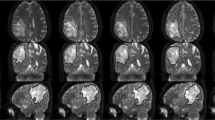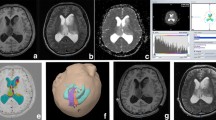Abstract
Objectives
To compare the histogram features of multiple diffusion metrics in predicting the grade and cellular proliferation of meningiomas.
Methods
Diffusion spectrum imaging was performed in 122 meningiomas (30 males, 13–84 years), which were divided into 31 high-grade meningiomas (HGMs, grades 2 and 3) and 91 low-grade meningiomas (LGMs, grade 1). The histogram features of multiple diffusion metrics obtained from diffusion tensor imaging (DTI), diffusion kurtosis imaging (DKI), mean apparent propagator (MAP), and neurite orientation dispersion and density imaging (NODDI) in the solid tumours were analysed. All values between the two groups were compared with the Man-Whitney U test. Logistic regression analysis was applied to predict meningioma grade. The correlation between diffusion metrics and Ki-67 index was analysed.
Results
The DKI_AK (axial kurtosis) maximum, DKI_AK range, MAP_RTPP (return-to-plane probability) maximum, MAP_RTPP range, NODDI_ICVF (intracellular volume fraction) range, and NODDI_ICVF maximum values were lower (p < 0.0001), whilst the DTI_MD (mean diffusivity) minimum values were higher in LGMs than those in HGMs (p < 0.001). Amongst the DTI, DKI, MAP, NODDI, and combined diffusion models, no significant differences were found in areas under the receiver operating characteristic curves (AUCs) for grading meningiomas (AUCs, 0.75, 0.75, 0.80, 0.79, and 0.86, respectively; all corrected p > 0.05, Bonferroni correction). Significant but weak positive correlations were found between the Ki-67 index and DKI, MAP, and NODDI metrics (r = 0.26–0.34, all p < 0.05).
Conclusions
Whole tumour histogram analyses of the multiple diffusion metrics from four diffusion models are promising methods in grading meningiomas. The DTI model has similar diagnostic performance compared with advanced diffusion models.
Key Points
• Whole tumour histogram analyses of multiple diffusion models are feasible for grading meningiomas.
• The DKI, MAP, and NODDI metrics are weakly associated with the Ki-67 proliferation status.
• DTI has similar diagnostic performance compared with DKI, MAP, and NODDI in grading meningiomas.





Similar content being viewed by others
Abbreviations
- AD:
-
Axial diffusivity
- AK:
-
Axial kurtosis
- AUCs:
-
Areas under the curves
- DKI:
-
Diffusional kurtosis imaging
- DSI:
-
Diffusion spectrum imaging
- DTI:
-
Diffusion tensor imaging
- FA:
-
Fractional anisotropy
- FOV:
-
Field of view
- HGMs:
-
High-grade meningiomas
- ICVF:
-
Intracellular volume fraction
- ISOVF:
-
Volume fraction of the isotropic compartment
- LGMs:
-
Low-grade meningiomas
- MAP:
-
Mean apparent propagator
- MD:
-
Mean diffusivity
- MK:
-
Mean kurtosis
- MKT:
-
Mean kurtosis tensor
- MSD:
-
Mean squared diffusion
- NODDI:
-
Neurite orientation dispersion and density imaging
- ODI:
-
Orientation dispersion index
- QIV:
-
Q-space inverse variance
- RD:
-
Radial diffusivity
- RK:
-
Radial kurtosis
- ROC:
-
Receiver operating characteristic curve
- RTAP:
-
Return-to-axis probability
- RTOP:
-
Return-to-origin probability
- RTPP:
-
Return-to-plane probability
- T1WI:
-
T1-weighted image
- T2WI:
-
T2-weighted image
- VOI:
-
Volume of interest
- WHO:
-
World Health Organization Classification
References
Ostrom QT, Patil N, Cioffi G, Waite K, Kruchko C, Barnholtz-Sloan JS (2020) CBTRUS Statistical Report: primary brain and other central nervous system tumours diagnosed in the United States in 2013–2017. Neuro Oncol 22:iv1-iv96
Louis DN, Perry A, Wesseling P et al (2021) The 2021 WHO Classification of Tumours of the Central Nervous System: a summary. Neuro Oncol 23:1231–1251
Maggio I, Franceschi E, Tosoni A et al (2021) Meningioma: not always a benign tumour. A review of advances in the treatment of meningiomas. CNS Oncol 10:Cns72
Corona AM, Di L, Shah AH et al (2021) Current experimental therapies for atypical and malignant meningiomas. J Neurooncol 153:203–210
Lin BJ, Chou KN, Kao HW et al (2014) Correlation between magnetic resonance imaging grading and pathological grading in meningioma. J Neurosurg 121:1201–1208
Kawahara Y, Nakada M, Hayashi Y et al (2012) Prediction of high-grade meningioma by preoperative MRI assessment. J Neurooncol 108:147–152
Aslan K, Gunbey HP, Tomak L, Incesu L (2018) The diagnostic value of using combined MR diffusion tensor imaging parameters to differentiate between low- and high-grade meningioma. Br J Radiol 91:20180088
Sanverdi SE, Ozgen B, Oguz KK et al (2012) Is diffusion-weighted imaging useful in grading and differentiating histopathological subtypes of meningiomas? Eur J Radiol 81:2389–2395
Lin L, Bhawana R, Xue Y et al (2018) Comparative analysis of diffusional kurtosis imaging, diffusion tensor imaging, and diffusion-weighted imaging in grading and assessing cellular proliferation of meningiomas. AJNR Am J Neuroradiol 39:1032–1038
Wang S, Kim S, Zhang Y et al (2012) Determination of grade and subtype of meningiomas by using histogram analysis of diffusion-tensor imaging metrics. Radiology 262:584–592
Tang Y, Dundamadappa SK, Thangasamy S et al (2014) Correlation of apparent diffusion coefficient with Ki-67 proliferation index in grading meningioma. AJR Am J Roentgenol 202:1303–1308
Chen XD, Lin L, Wu J et al (2020) Histogram analysis in predicting the grade and histological subtype of meningiomas based on diffusion kurtosis imaging. Acta Radiol 61:1228–1239
Avram AV, Sarlls JE, Barnett AS et al (2016) Clinical feasibility of using mean apparent propagator (MAP) MRI to characterize brain tissue microstructure. Neuroimage 127:422–434
Zhang H, Schneider T, Wheeler-Kingshott CA, Alexander DC (2012) NODDI: practical in vivo neurite orientation dispersion and density imaging of the human brain. Neuroimage 61:1000–1016
Figini M, Riva M, Graham M et al (2018) Prediction of isocitrate dehydrogenase genotype in brain gliomas with MRI: single-shell versus multishell diffusion models. Radiology 289:788–796
Gao A, Zhang H, Yan X et al (2022) Whole-tumour histogram analysis of multiple diffusion metrics for glioma genotyping. Radiology 302:652–661
Mao C, Jiang W, Huang J et al (2022) Quantitative parameters of diffusion spectrum imaging: HER2 status prediction in patients with breast cancer. Front Oncol 12:817070
Song Y, Zhang J, Zhang YD et al (2020) FeAture Explorer (FAE): a tool for developing and comparing radiomics models. PLoS One 15:e0237587
She D, Lin S, Guo W, Zhang Y, Zhang Z, Cao D (2021) Grading of pediatric intracranial tumours: are intravoxel incoherent motion and diffusional kurtosis imaging superior to conventional DWI? AJNR Am J Neuroradiol 42:2046–2053
Buerki RA, Horbinski CM, Kruser T, Horowitz PM, James CD, Lukas RV (2018) An overview of meningiomas. Future Oncol 14:2161–2177
Xing F, Tu N, Koh TS, Wu G (2017) MR diffusion kurtosis imaging predicts malignant potential and the histological type of meningioma. Eur J Radiol 95:286–292
Özarslan E, Koay CG, Shepherd TM et al (2013) Mean apparent propagator (MAP) MRI: a novel diffusion imaging method for mapping tissue microstructure. Neuroimage 78:16–32
Wang P, Weng L, Xie S et al (2021) Primary application of mean apparent propagator-MRI diffusion model in the grading of diffuse glioma. Eur J Radiol 138:109622
Zhao J, Li JB, Wang JY et al (2018) Quantitative analysis of neurite orientation dispersion and density imaging in grading gliomas and detecting IDH-1 gene mutation status. Neuroimage Clin 19:174–181
Li SH, Jiang RF, Zhang J et al (2019) Application of neurite orientation dispersion and density imaging in assessing glioma grades and cellular proliferation. World Neurosurg 131:e247–e254
Acknowledgements
The authors thank Xueyong Liu, MD, and Henggui Chen, PhD, at the First Affiliated Hospital of Fujian Medical University, Fuzhou, China, for pathologic support and statistical support, respectively.
Funding
This study has received funding from the Fujian Provincial Health Technology Project (No. 2021GGA025), the National Natural Science Foundation of China (No. 82071869), and the Joint Funds of the Innovation of Science and Technology of Fujian Province (No. 2019Y9115).
Author information
Authors and Affiliations
Corresponding author
Ethics declarations
Guarantor
The scientific guarantor of this publication is Dairong Cao.
Conflict of interest
The authors of this manuscript declare relationships with the following companies:
Xiance Zhao and Yun Kang are employees of Philips Healthcare. Both of them provided technical support in this study under Philips collaboration regulation without any payment and personal concern regarding this study. The remaining authors declare no relationships with any companies whose products or services may be related to the subject matter of the article.
Statistics and biometry
One of the authors has significant statistical expertise.
Informed consent
Written informed consent was not required for this study because this is a retrospective study, and patient data are anonymised.
Ethical approval
Institutional Review Board approval was obtained.
Methodology
• retrospective
• diagnostic study
• performed at one institution
Additional information
Publisher's note
Springer Nature remains neutral with regard to jurisdictional claims in published maps and institutional affiliations.
Dejun She and Hao Huang contributed equally to this study and should be considered co-first authors.
Supplementary Information
Below is the link to the electronic supplementary material.
Rights and permissions
Springer Nature or its licensor (e.g. a society or other partner) holds exclusive rights to this article under a publishing agreement with the author(s) or other rightsholder(s); author self-archiving of the accepted manuscript version of this article is solely governed by the terms of such publishing agreement and applicable law.
About this article
Cite this article
She, D., Huang, H., Guo, W. et al. Grading meningiomas with diffusion metrics: a comparison between diffusion kurtosis, mean apparent propagator, neurite orientation dispersion and density, and diffusion tensor imaging. Eur Radiol 33, 3671–3681 (2023). https://doi.org/10.1007/s00330-023-09505-3
Received:
Revised:
Accepted:
Published:
Issue Date:
DOI: https://doi.org/10.1007/s00330-023-09505-3




